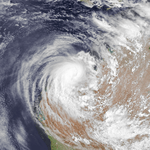1986–87 Australian region cyclone season
1986–87 Australian region cyclone season
| |
| Season summary map |
| First system formed |
15 January 1987 |
| Last system dissipated |
27 May 1987 |
| Strongest storm1 |
Elsie – 940 hPa (mbar), 175 km/h (110 mph) (10-minute sustained) |
| Tropical lows |
7 |
| Tropical cyclones |
7 |
| Severe tropical cyclones |
2 |
| Total fatalities |
0 |
| Total damage |
$0,000 (1987 USD) |
| 1Strongest storm is determined by lowest pressure |
Australian region tropical cyclone seasons
1984–85, 1985–86, 1986–87, 1987–88, 1988–89 |
| Related articles |
|
|
The 1986–87 Australian region cyclone season was a slightly below average season. It officially started on 1 November 1986, and officially ended on 30 April 1987.
Seasonal summary
Storms
Severe Tropical Cyclone Connie
| Category 3 severe tropical cyclone (Australian scale) |
| Tropical storm (SSHWS) |
|
|
| Duration |
15 January – 23 January |
| Peak intensity |
155 km/h (100 mph) (10-min) 950 hPa (mbar) |
Connie, 15 to 23 January 1987. Made landfall over Port Hedland on 19 January. Moderate damage was reported in Port Hedland and Whim Creek.
Tropical Cyclone Irma
| Category 2 tropical cyclone (Australian scale) |
| Tropical depression (SSHWS) |
|
|
| Duration |
19 January – 22 January |
| Peak intensity |
100 km/h (65 mph) (10-min) 980 hPa (mbar) |
Irma, 19 to 22 January 1987, Gulf of Carpentaria
Tropical Cyclone Damien
| Category 2 tropical cyclone (Australian scale) |
| Tropical storm (SSHWS) |
|
|
| Duration |
30 January – 9 February |
| Peak intensity |
100 km/h (65 mph) (10-min) 980 hPa (mbar) |
Damien, 30 January to 9 February 1987, near Western Australia
Tropical Cyclone Jason
| Category 2 tropical cyclone (Australian scale) |
| Category 1 tropical cyclone (SSHWS) |
|
|
| Duration |
4 February – 14 February |
| Peak intensity |
110 km/h (70 mph) (10-min) 970 hPa (mbar) |
Jason stuck the Northern Territory in February, 1987 damaging 20 buildings.
Severe Tropical Cyclone Elsie
| Category 4 severe tropical cyclone (Australian scale) |
| Tropical storm (SSHWS) |
|
|
| Duration |
21 February – 27 February |
| Peak intensity |
185 km/h (115 mph) (10-min) 940 hPa (mbar) |
Elsie, 21 to 27 February 1987, near Western Australia. Catastrophic damage was reported at Mandora Station.
Tropical Cyclone Kay
| Category 2 tropical cyclone (Australian scale) |
| Category 1 tropical cyclone (SSHWS) |
|
|
| Duration |
6 April – 17 April |
| Peak intensity |
110 km/h (70 mph) (10-min) 975 hPa (mbar) |
Kay, 6 to 17 April 1987, Papua-Newguinea and Western Australia
Tropical Cyclone Blanch(e)
| Category 2 tropical cyclone (Australian scale) |
| Tropical storm (SSHWS) |
|
|
| Duration |
22 May – 27 May |
| Peak intensity |
110 km/h (70 mph) (10-min) 990 hPa (mbar) |
Blanch, 22 to 27 May 1987, Pacific Ocean
Other systems
The precursor tropical low to Cyclone Uma formed within the region on 4 February, before it crossed 160°E and moved into the South Pacific basin later that day.[1] The precursor tropical low to Cyclone Veli formed during the next day, about 725 km (450 mi) to the south-east of Port Moresby in Papua New Guinea.[1] During the next day the low moved eastwards and gradually developed further, before it became equivalent to a category 1 tropical cyclone on the Australian scale, as it reached its 10-minute sustained windspeeds of 85 km/h (55 mph).[1] As the system continued to move eastwards it crossed 160°E and moved into the South Pacific basin during 7 February, before TCWC Nadi named it Veli later that day on the basis of satellite derived evidence.[1][2]
Seasonal effects
See also
- Atlantic hurricane seasons: 1987, 1988
- Eastern Pacific hurricane seasons: 1987, 1988
- Western Pacific typhoon seasons: 1987, 1988
- North Indian Ocean cyclone seasons: 1987, 1988
References
External links











